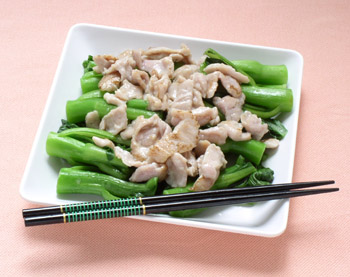
Feature Articles
(I) QUARANTINE DETECTOR DOGS (QDDs)
 |
 |
||
|---|---|---|---|
| Name: Diva | Breed: Beagle | Name: Max | Breed: Labrador |
Objectives of the QDD Programme
To strengthen efforts to combat the smuggling of live animals, animal products and raw meat, and to prevent the introduction of avian influenza and other animal diseases, the Centre for Food Safety (CFS) of the Food and Environmental Hygiene Department (FEHD) together with the Agriculture, Fisheries and Conservation Department (AFCD) jointly introduce a QDD Programme and establish a QDD unit.
The traits and training of QDDs
Apart from being fond of sniffing and eating, QDDs must also be physically fit, young and has an acceptable appearance. They should also be friendly, genial, calm, outgoing, brave, inquisitive, proactive and agile.
The serving QDDs came from Australia . Their years of service vary with species. Generally, Beagles can serve for eight to nine years and Labradors can serve for six to seven years.
QDD handlers are selected from serving Field Officers of the AFCD. They should have a keen interest in this new type of work and must be willing to provide care for their canine partners.
QDD and their handlers had undergone eight weeks of training in Sydney , Australia before coming to Hong Kong . They have then received another three weeks of field operational training at different land boundary crossings to adapt themselves to the working environment.
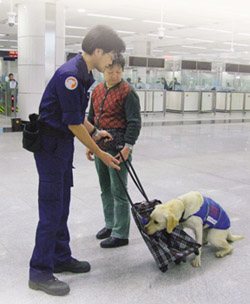
Are QDDs effective in detecting smuggled food?
Dogs have a more acute sense of smell than humans. They have approximately 220 million scent receptors, a lot more than humans who have only about five million. A trained dog can detect anything with a smell, such as raw meat, eggs and other prohibited foods. This natural ability of dogs has already been used by some law enforcement agencies, including Australia , Japan and the Mainland customs, to detect prohibited items in airports.
Where do QDDs work?
QDDs have already started performing their duties since February this year at different land boundary control points at Man Kam To, Sha Tau Kok, Lok Ma Chau, Lo Wu and Shenzhen Bay Port. If the QDDs suspect that a traveller is carrying raw meat into the territory, they will sit next to her/her as a signal.
(II) THE ROLE OF THE CENTRE FOR FOOD SAFETY IN THE 2008 OLYMPIC AND PARALYMPIC EQUESTRIAN EVENTS IN HONG KONG

Little Miss Agog :
Hi, Mr Food Safety, what has CFS been up to lately?

Mr Food Safety :
Beijing 2008 Olympic and Paralympic Equestrian Events (the Events) are going to take place in Hong Kong in August and September. A large number of athletes, team officials, journalists and visitors will come here from all over the world. Food safety during their stay is extremely important and we are busy working on this aspect.
Little Miss Agog :
What preparations are being made?
Mr Food Safety :
To ensure food safety, CFS has established a dedicated Food Safety Advisory Team (FSAT) for the Events. FSAT plays the advisory role and provides food hygiene and safety training to food handlers of designated caterers and hotels. Besides, training programmes are also provided for staff and volunteers appointed by the Equestrian Company. Moreover, food handlers and management staff of restaurants situated in the vicinities of the event venues and tourist areas have also been invited to attend seminars and training workshops to enhance their knowledge and awareness on food safety prior to the Events. These seminars and workshops, which have been held since March, have received a generous response.
Little Miss Agog :
No wonder you are so busy! What else is underway besides the seminars and workshops?
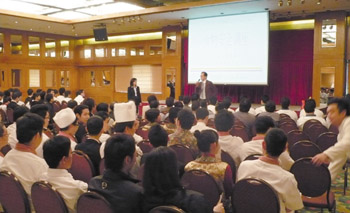
Mr Food Safety :
The FSAT has visited the designated caterers and hotels to offer advice and assistance to them in developing an appropriate food safety management system based on the seven principles of Hazard Analysis Critical Control Point to monitor food safety during the Equestrian periods. The team members also help to screen the food menus to identify high risk food items and ensure that they are safe for consumption.
CFS has also implemented targeted food surveillance programme for the Events to collect different food samples for microbiological and chemical tests to ensure food safety. We will, of course, continue with stringent inspection on imported food. Importation of food from infected areas will be strictly prohibited.
Little Miss Agog :
Are there any contingency measures should food incidents or complaints arise during the Events?
Mr Food Safety :
Of course there are. FEHD and Department of Health (DH), which have always maintained close collaboration, have developed protocols in handling food poisoning outbreak. Furthermore, FEHD has formulated contingency and action plans for the Events and put more staff on call to handle food incidents during the Equestrian periods.
Should there be an incident, DH will carry out investigation and identify the restaurant involved. We will then send our staff to the restaurant for immediate investigation and implement appropriate control measures to ensure food safety. To enhance cooperation among relevant government departments, we have been conducting drills and exercises to test our response and follow-up actions in case food incidents occur.
Little Miss Agog :
Your work is very important indeed. Please keep up!
(III) Nutrition Labelling
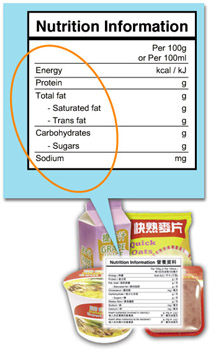
Why do we need to regulate nutrition labelling?
The Food and Drugs (Composition and Labelling) (Amendment: Requirements for Nutrition Labelling and Nutrition Claim) Regulation 2008 (the Amendment Regulation) was published in the Gazette on 3 April 2008 . The Government proposes to introduce a nutrition labelling scheme with a view to assisting consumers to make healthy food choices, encouraging food manufacturers to apply sound nutrition principles in the formulation of foods which would benefit public health and regulating misleading or deceptive labels and claims.
What is "1+7"?
To provide consumers with nutrition information about individual food products, a mandatory nutrition labelling scheme for prepackaged food is introduced in Hong Kong . This requires all prepackaged food to label energy plus seven core nutrients – protein, carbohydrates, total fat, saturated fat, trans fat, sodium and sugars (i.e. "1+7") as well as any nutrients for which a nutrition claim is made.
What is a nutrition claim?
A nutrition claim means any representation which states, suggests or implies that a food has particular nutritional properties. The proposed Nutrition Labelling Scheme makes reference to the guidelines of the Codex Alimentarius Commission and allows foods to make claims that are commonly used in the local market, such as the "low-sugar" claim and the "trans fat free" claim. Regulation over nutrition claims covers nutrient content claims, nutrient comparative claims and nutrient function claims. Nutrition claims on food labels and advertisements are to be regulated.
Will the introduction of nutrition labelling affect the food imported to Hong Kong ?
Hong Kong imports about 60% of prepackaged food from overseas. The Government has struck a balance between the consumers' right to information and food choices in formulating the Nutrition Labelling Scheme. To minimise the impact on food choice, the Government has introduced a small volume exemption scheme and allowed flexibility in the labelling format for the trade with practical difficulty in observing the requirements. These measures seek to facilitate compliance by the trade.
When will the Amendment Regulation come into force?
The Amendment Regulation will come into force in July 2010, after a grace period of about two years.
What measures will be put in place to promote the Scheme?
The Government will step up effort to promote the benefits of nutrition labelling and educate the public on how to interpret the nutrition information in the labels. The CFS has set up a special Task Force on Nutrition Labelling Education comprising representatives from various professional organisations, like the Hong Kong Medical Association, to coordinate public education and promotional activities on nutrition labelling. Moreover, the CFS will produce publicity materials like posters and pamphlets, and organise other promotional activities.
(IV) Using Disposable Plastic Food Containers– Is it safe?

Common disposable food containers
Disposable food containers are commonly used by the food trade to cater to the need of customers for take-away food. Such containers are so widely used by food establishments, retailers and school lunch box suppliers that the safety of the materials used for manufacturing the containers has again aroused public concern. Such containers are often made with polypropylene (PP), expanded polystyrene (EPS, commonly known as poly-foam), polystyrene (PS) or polyethylene terephthalate (PET). Among them, PP can withstand high temperatures ranging from 100oC to 120oC for long periods, whereas the other three types of plastics are not suitable for keeping food at temperatures over 100oC.
Are plastic containers safe?
FEHD conducted a study with the Consumer Council on the safety of disposable containers in 2005. The results showed that plastic disposable food containers, if properly used, would unlikely cause food safety problems. The study recommended that the food trade should identify the characteristics of the containers, e.g., the temperatures and degrees of acidity which the containers can withstand, and purchase containers that meet the requirements. The containers must be able to protect the food from contamination. Also, they should not be deformed as a result of high temperature, and must not release to the food any harmful substance in an amount that may endanger health.
Adverse health effects caused by containers of low quality or improper use of containers
As a result of their manufacturing process, disposable containers may contain chemical residues such as styrene or vinyl chloride monomers, and the plastic materials may also contain heavy metal impurities which may migrate to the food and cause adverse health effects to consumers. In addition, other substances (e.g. additives used in the manufacturing of plastic materials) may also migrate to the food, though these substances in general are of low toxicity.
The amounts of the above substances that may migrate to the food are related to the type and temperature of the food as well as the duration of contact with the container. Therefore, the appropriate type of plastic containers should be chosen for the food of interest.
Guidelines on the use of disposable containers
When using disposable food containers, the public and the trade should minimise the time for the food being in contact with the container, and hence reduce the risk of migration of toxic chemicals from the container to the food. If the container is deformed after holding hot food, stop using the container and discard the food. When using a microwave oven to reheat take-away meals, ensure that the container is suitable for use in microwave ovens. For example, EPS containers are not microwaveable. If in doubt, reheat the food in a microwaveable container. Generally speaking, disposable plastic containers that are microwaveable should not be reheated in microwave ovens more than once.
To help the food trade to select and use appropriate disposable containers, the CFS has published guidelines on the use of disposable plastic containers. According to the guidelines, the trade should adopt the following measures when using disposable plastic containers for take-away meals: When choosing disposable containers, take into account the characteristics of the food to be contained (e.g. whether the food is fatty, oily or acidic), the food temperature and the duration of storage in the container. The staff should inspect the labels on the containers to find out about the applications and properties of the containers (e.g. their moisture proofing ability and resistance to heat, acid and impact), and check the containers to ensure that the packaging are intact and there is no sign of contamination. The trade should also request supportive documents such as laboratory test reports from the suppliers as far as possible to ensure that the containers and their lids are suitable for their intended use.
Readers' Corner
(I) Risk of Mercury in Fish
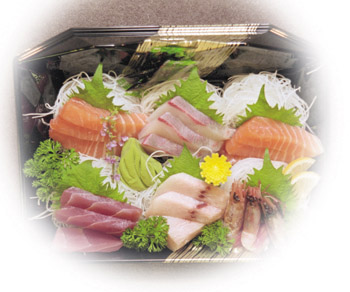
As fish are a good source of high-quality protein and Omega-3 fatty acids, moderate consumption of fish is good to health.
What is "Mercury"?
Mercury is a metallic element. Pure mercury is shiny, silver white and liquid at room temperature. It is commonly used to manufacture products like thermometers, electrical switches, some types of light bulbs, etc. Mercury exists in three forms, namely metallic, inorganic and organic. Methylmercury, which is the most prevalent form of organic mercury, is the most toxic one. According to the Food Adulteration (Metallic Contamination) Regulations, the maximum permitted concentration of total mercury including methylmercury in food is 0.5ppm (i.e. 500μg/kg).
Why is mercury present in fish?
In streams, lakes and oceans, mercury can be transformed by bacteria and micro-organisms into methylmercury. Methylmercury, the most toxic form of mercury, is readily passed from microorganisms to larger organisms via the food chain. When fish eat these microorganisms, methylmercury can accumulate in fish and go up the food chain when larger fish eat smaller fish. Fish and aquatic organisms, especially predatory fish at the top of the food chain with longer lifespan and larger size such as swordfish, shark and marlin, would have a greater tendency to accumulate higher amount of methylmercury.
What are the effects of mercury on health?
Exposure to high level of mercury from the diet can cause adverse effect to the nervous system, especially to the developing brain. Hence, developing foetuses, infants and young children are more sensitive to such toxic effects.
Results of Mercury in Fish and Food Safety Study
The CFS announced the results of a risk assessment study on "Mercury in Fish and Food Safety" on 16 April 2008 . The study shows that most of the fish available in the Hong Kong market have relatively low level of mercury, while a small proportion contains higher level. The level of mercury in fish varies and depends on their species, age, food sources and living environments. The results of this study together with reports from other countries show that high mercury level is usually found in some predatory fish species such as shark, swordfish, marlin, alfonsino and some types of tuna, while lower level is found in fish such as salmon, sardine, grass carp, mud carp, grey mullet, pomfret, rabbitfish, bighead carp, horsehead, yellow croaker, mandarin fish, golden thread and bigeye. Since the level of mercury in individual fish may vary according to the source and living environment, consumers are advised to maintain a balanced diet.
Advice to the Trade
- Obtain food supplies from reliable sources.
- Maintain proper records to enable source tracing when required.
- Inform customers of the type of fish and fish products being sold.
(II) Understanding Paralytic Shellfish Poisoning Toxins (Biotoxins)
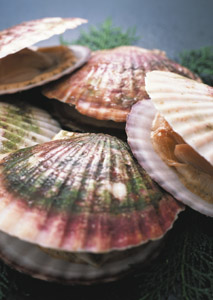
Paralytic Shellfish Poisoning Toxins
Animal natural toxins are substances produced by animals as a result of body metabolism, or chemicals absorbed through the food chain. Consumption of animals carrying natural toxins may result in poisoning. Generally speaking, poisoning after eating terrestrial animals is relatively uncommon. Toxins produced by toxic microalgae may, however, accumulate in marine animals such as shellfish, crustacean and finfish after feeding on these microalgae. The concentration of shellfish toxins is higher in the viscera of contaminated shellfish. Poisoning due to toxins after ingestion of these marine animals is reported in many parts of the world.
The major types of shellfish toxin poisoning commonly encountered are Paralytic Shellfish Poisoning (PSP), Ciguatera Poisoning (CP), Neurotoxic Shellfish Poisoning (NSP), Diarrhoetic Shellfish Poisoning (DSP) and Amnesic Shellfish Poisoning (ASP). In Hong Kong , PSP is the most commonly reported shellfish toxin poisoning, followed by NSP and DSP. Scallop is the most frequently involved food item.
Public health significance
PSP may lead to acute toxicity in humans. The level of PSP toxins which leads to toxicity symptoms varies considerably between individuals. According to literature, the symptoms of PSP in humans may be caused by a dose as low as 120 micrograms, but it may also take a dose of over 1 000 micrograms to cause mild symptoms in some cases.
Symptoms of PSP
The symptoms of PSP are predominantly neurological and usually appear within minutes to hours after ingestion of the shellfish. Initial symptoms may include tingling, numbness of the mouth and extremities, headache, dizziness and gastrointestinal discomfort. In the majority of cases, symptoms resolve completely within a few days. In severe cases, difficulty in swallowing and speech, paralysis with respiratory arrest and even death may occur. There is currently no antidote for PSP toxins and clinical management for affected individuals is therefore supportive.
Advice to the Trade
- Source shellfish from reputable suppliers.
- Maintain a good recording system to trace source, if necessary.
Food News
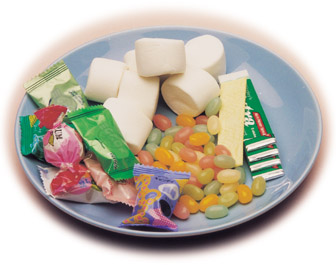
Sugars and Sugar Substitutes
Although sugars add sweetness to food and enhance the pleasure of eating, they should be consumed in moderation. Sugars are carbohydrates, they give out 4 kilocalories (kcal) per gram upon digestion and metabolism. Glucose and sucrose are common examples. Excessive consumption of sugars from our diet may lead to excessive intake of calories and gain in body weight. In addition, sugars can cause dental caries.
"Free sugars" are those monosaccharides and disaccharides added to foods, plus sugars naturally present in honey, syrups and fruit juices. In view of the fact that free sugars will increase the total energy of diet and affect body weight, the World Health Organization and the Food and Agriculture Organization recommend that no more than 10% of daily energy intake should be derived from free sugars. For example, a person whose daily energy intake is 2 000 kcal should limit the intake of free sugars to less than 50 grams per day. For instance, a teaspoon of white granulated sugar (approximately weighs 4 grams) can provide 16 kcal.
As consumers strive to maintain a healthy body weight in recent years, the demand for low-calorie sweet- tasting food products is ever increasing. Over the past few decades, low-calorie sweeteners have been widely used and have become common ingredients in various food items and beverages such as soft drinks, candies, chewing gum, yoghurt and desserts. Common examples of low-calorie sweeteners include aspartame, acesulfame potassium and cyclamic acid. Although they have very little or no caloric values, they are substantially sweeter than sugars and can be applied at very low levels in foods to give enough sweetness, resulting in calorie-savings. For instance, 1 gram of aspartame can replace 200 grams of sucrose, providing 4 kcal of energy instead of 800 kcal from sucrose. Low-calorie sweeteners can help consumers cut down on calories intake and control body weight. As low-calorie sweeteners do not affect insulin or glucose levels, they can also help to manage chronic conditions like diabetes. Replacing sugars with low-calorie sweeteners in foods will not contribute to tooth decay.
Legislative Amendments
(I) Preservatives in Food (Amendment) Regulation 2008
The Preservatives in Food (Amendment) Regulation 2008 (the Amendment Regulation) was published in the Gazette on 18 April 2008 (L.N. 85 of 2008) and passed by the Legislative Council. The Amendment Regulation is effective from 1 July 2008 .
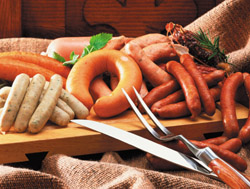
Major amendments include the following:
- amendment of the definition of antioxidants;
- incorporation of those preservatives and antioxidants, as well as their permitted levels of use, that are listed in the Codex General Standard for Food Additives (GSFA) into the Amendment Regulation, with modification to suit the local situation;
- adoption of a food category system based on the GSFA.
(II) Colouring Matter in Food (Amendment) Regulation 2008
The Colouring Matter in Food (Amendment) Regulation 2008 was published in the Gazette on 2 May 2008 (L.N.98 of 2008) and passed by the Legislative Council. With effect from 1 December 2008 , Red 2G will be removed from the list of permitted colouring matters.
Upon the commencement of the Amendment Regulation, a person will commit an offence if he sells, consigns or delivers, or imports any food that contains Red 2G or sells or advertises for sale Red 2G for use in food.
For further information about the Amendment Regulations, please visit the web site of the CFS: www.cfs.gov.hk.
Food Safety Plan Corner
Critical Control Point of Preparing Stir-fried Choi Sum with Sliced Pork (For Trade)
Ensure food safety
Enjoy food safely
Critical Control Point of Preparing Stir-fried Choi Sum with Sliced Pork
Ensure food safety Enjoy food safely
Modern people are more and more health-conscious. The Department of Health has launched the "EatSmart@restaurant.hk" campaign to encourage the trade to prepare dishes with more fruit and vegetables, so that people can enjoy healthier food when eating out. In view of this, we have chosen a vegetable-based dish in this issue — stir-fried choi sum with sliced pork. We will introduce and illustrate the critical control points that should be noted when preparing the dish, including the safety tips for preparing vegetables. We hope that the trade can ensure food safety while striving to improve the colour, aroma and taste as well as the nutritional value of food, so that consumers can enjoy safely.
| Ingredients | |
|---|---|
| Choi sum....................... | 300 g (about 7-8 taels) |
| Lean pork....................... | 150 g (about 4 taels) |
| Seasoning | |
| Ginger............................ | 5 g |
| Garlic............................. | 10 g |
| Salt................................ | 1 tsp. |
| Light soy sauce.............. | 1 tbs. |
| Shaoxing wine................ | 2 tsp. |
| Oil.................................. | 1 tbs. |
| Steps | |
|
|
Production Process
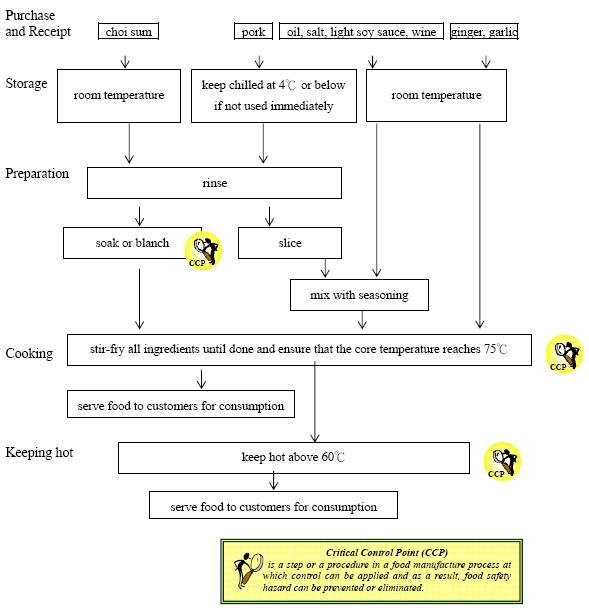
Guidelines on Production of Stir-fried Choi Sum with Sliced Pork
- Purchase and receipt
When buying and receiving the ingredients, make sure that
- the vegetable is fresh and not rotten;
- the pork is purchased from a licensed "Fresh Provision Shop" and its colour is not abnormally red;
- if chilled pork is used, store it in the refrigerator at 4oC or below;
- all pre-packaged food items (e.g. oil and salt) are used before the expiry date.
- Storage
Store the ingredients immediately at safe temperature
- Chilled pork or fresh pork not for immediate use should be stored in the refrigerator. The temperature inside the refrigerator should be checked regularly with a thermometer and recorded to ensure that the fridge remains at 4oC or below.
- Raw pork should be properly wrapped or stored in a container with a lid, and put under cooked food or ready-to-eat food. Raw food and cooked food should most preferably be stored in different refrigerators.
- Practise the first-in-first-out principle for storage. Check and record the storage date of the ingredients.
- Preparation
Before cooking, rinse choi sum and pork
CFS's Safety Tips on Preparing Vegetables (CCP)
To reduce pesticide residues that may be present in choi sum, after rinsing the vegetable,
- soak in water for an hour; or
- blanch for a minute.
Wash all food contact surfaces (including worktops, cutting boards and utensils).
Before cooking / when preparing food, wash hands thoroughly with warm water and liquid soap.
Use two different sets of knives and cutting boards for handling raw pork and cooked food or ready to eat food. Use different sets of utensils (e.g. bowls, plates and chopsticks) for marinating pork and serving cooked food.
Marinated pork not for cooking immediately should be stored in a refrigerator at 4 oC or below.
- Cooking
The pork should be thoroughly cooked until the meat juice becomes clear and not red.
It is advised that a clean food thermometer be used to measure the core temperature of food, which should reach at least 75 oC. (CCP)
- Keeping hot / Consumption
The cooked food should be served to customers for consumption as soon as possible. It should not be kept at room temperature for more than two hours.
The food not for immediate consumption should be kept hot in a pre-heated plate or steamed pot above 60 oC. (CCP)
- Management System
A preventive food safety management system (such as the Hazard Analysis Critical Control Point) should be implemented to identify and control any food safety problems that may emerge during production.
